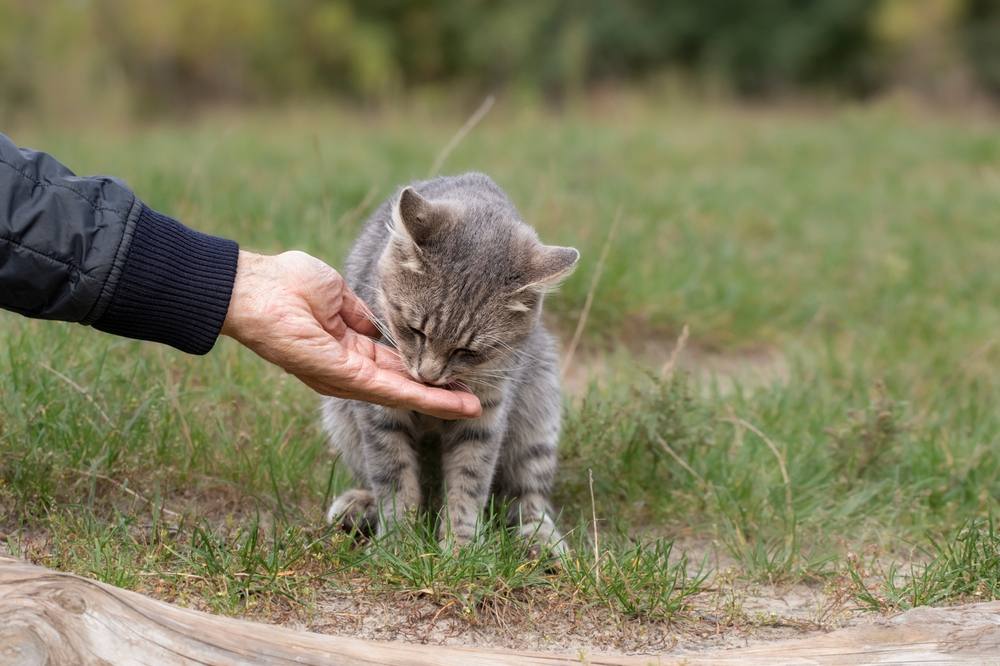
movchanzemtsova / Shutterstock
There are 30 to 80 million stray, feral, uncared, and homeless cats living in the United States. When a cat follows you home, or you find a feline in the street and want to help, it’s essential to determine whether the cat you found is stray or feral.
Getting a stray cat to approach you voluntarily requires patience, dedication, compassion, and a calming disposition. Read on to learn how to get a stray cat to come up to you with a few simple steps.
Also Read: Can Cats Sense if You Don’t Like Them?
There are important differences to note between stray and feral cats. Approaching and capturing stray cats takes time, but can be done with patience and consistency. Whether you adopt a stray cat, reunite it with its owner, or take it to a shelter for eventual adoption, rescued cats should be taken to a veterinarian to assess their health and to look for microchips.Key Takeaways
How Do You Get A Stray Cat To Come To You?
There are differences between stray and feral cats that should be noted before approaching an unknown cat. Follow the eight steps outlined below to build trust with a stray cat and get them to come within reach.
Step 1: Determine Whether The Cat Is A Stray Or Feral

Some stray and feral cats live in colonies near convenient resources for their survival.
Feral cats are free-living as single or colony cats, usually born in the wild to abandoned pet cats or feral non-neutered felines. Feral cats generally have little or no direct human interaction and fear people.
If you find a cat outdoors whose head and tail are low, eyes wide open with enlarged pupils, ready to fight or flight the minute you decrease distance, and then hiss and run away, most likely it’s a feral cat.
When you find a cat with its ear tip clipped, it signifies that this community cat has been part of a Trap-Neuter-Return (TNR) program and has been vet checked, vaccinated, neutered, and released back into the area.
Stray cats previously lived indoors and were cared for by humans and are now free-living outdoors due to abandonment or getting lost. Stray cats may tolerate or approach people, allow human contact, and accept petting and food to some extent.
When you stumble onto a cat who greets you with head and tail held high, meowing as if to say, “I’m lost, help me,” then it is definitely a stray cat. Most strays find it challenging to adapt to living outdoors and sourcing food when lost or neglected. Their coat will likely be dirtier and disheveled, and they will be malnourished compared to a feral cat who can survive in the wild and usually will hide during the daytime.
Stray cats can become pet cats under the right conditions and with the proper care. If you’re sure it’s a stray cat, proceed to the next step.
Also Read: What Is the Difference Between a Stray Cat and a Feral Cat?
Step 2: Gain The Cat’s Trust By Luring It With Food And Water

Food and water are major motivators for stray cats to approach a stranger.
Stray cats are always hungry since they are not used to hunting for food, as guardians always provided their meals. Food and water are significant motives and a guaranteed method to build trust.
Place smelly food like tuna, canned cat food, or cooked meat to lure them out of hiding. Refrain from leaving milk since most cats are lactose intolerant, which can cause stomach upset.
While the cat consumes their food, move away. Dn’t stare at the cat since felines are solitary hunters/feeders. They need to feel safe and secure and prefer to eat alone.
Place the bowl out of sight of other prey animals and away from the elements. Keep the same feeding routines for several days, weeks, and months until the cat feels safe to come out of hiding.
Also Read: How Much Should Cats Eat And How Often
Step 3: Progress To Building A Positive Relationship With The Unowned Cat

Be patient when developing a relationship with a stray cat. It takes time to build trust that will lead to a positive association.
Patiently build a positive connection with the stray cat by moving its food bowl closer and closer to you. Sit quietly on the ground or on a low chair while the cat feels comfortable eating in your presence. You can talk to the cat in a calm, quiet voice, withholding from sudden movements.
If the cat feels safe enough to leave their hiding spot voluntarily and approach you, refrain from petting them. Doing so may undo all the trust you built, especially if the cat is anxious. If it’s freezing outside, make a temporary cat shelter out of Styrofoam or place a soft cat bed in the vicinity to keep the cat warm until it feels confident to approach you or get rescued.
Some unowned cats will disappear for days, but most will return after a nominated period. If you’re concerned about the cat’s welfare and wish to rescue it, progress to the next stage.
Also Read: The 5 Best Outdoor Cat Houses
Step 4: Prepare a Rescue Kit With Several Cat Capture Options
Now that you built a rapport with the unowned cat who trusts you, prepare a rescue kit. A rescue kit consists of gloves, a cat carrier, a kennel or a cat trap, towels or blankets, canned cat food, water, a first aid kit, and a list of veterinarians in the local area.
Also Read: What Is TNR For Cats?
Step 5: Accustom the Cat to the Carrier or Cage a Few Weeks Before Trapping
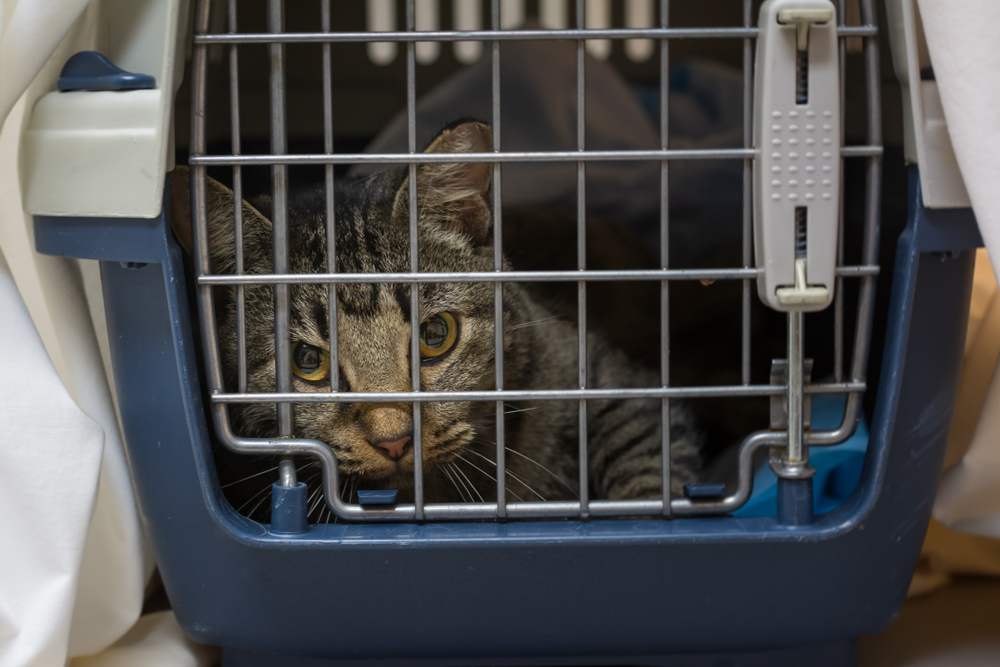
Choose a carrier, kennel, or cage and accustom the cat to it a few weeks before capture by positioning the canned food close to the humane trap. Gradually place food, water, and a blanket within the crate, leaving the door open. The cat should become familiar with entering and leaving the enclosure without fear or incident.
Also Read: How to Get A Cat Into A Carrier: 6 Steps For Success
Step 6: Plan The Exact Time Of The Capture
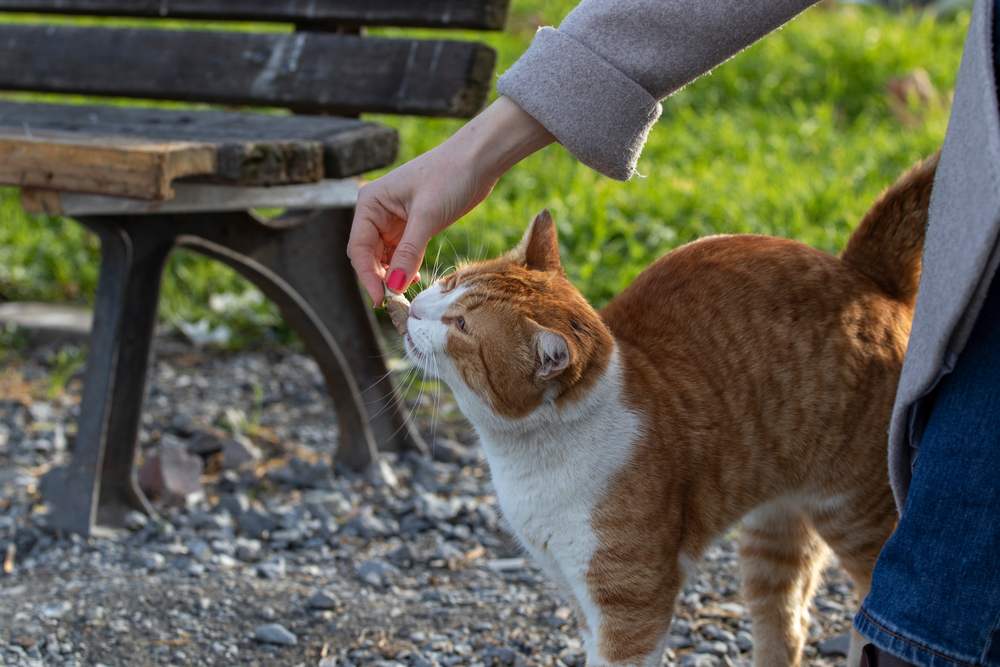
Timing is crucial when it comes to cat rescues.
It’s essential to plan the timing of your capture. Stay away from busy, crowded areas and periods. Avoid extreme weather like heatwaves or storms since most cats will remain hidden during them. Ensure the surroundings are tranquil and the cat is comfortable accessing the enclosure while you’re in the vicinity.
Also Read: How To Care For Feral Cats
Step 7: Proceed to Trap the Stray Cat Calmly
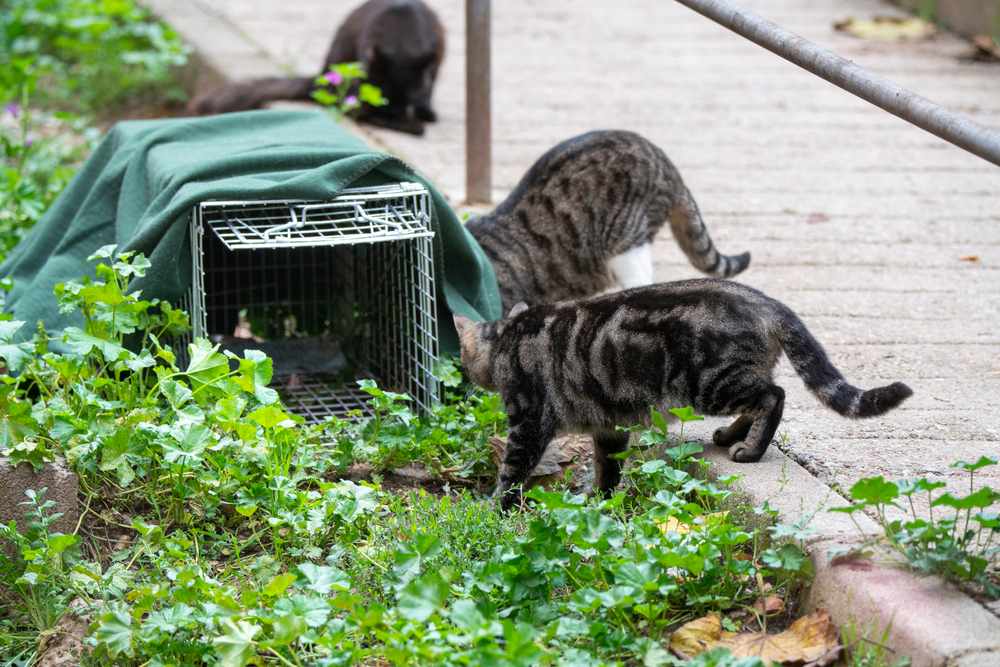
When capturing stray cats, do so with patience and as little stress for the cat as possible.
Don’t feed the stray cat for twenty-four hours before capture to ensure they are hungry. Place the trap in a familiar environment next to where they usually eat to seem less threatening. Place a small amount of tuna inside the carrier or crate. Remain calm and quiet but avert your gaze. When the cat is within, shut the gate. Once you trap the stray, cover the trap with a towel or blanket to minimize thrashing.
Also Read: How To Catch A Cat With A Towel
Step 8: Take the Stray Cat to the Veterinarian for a Checkup
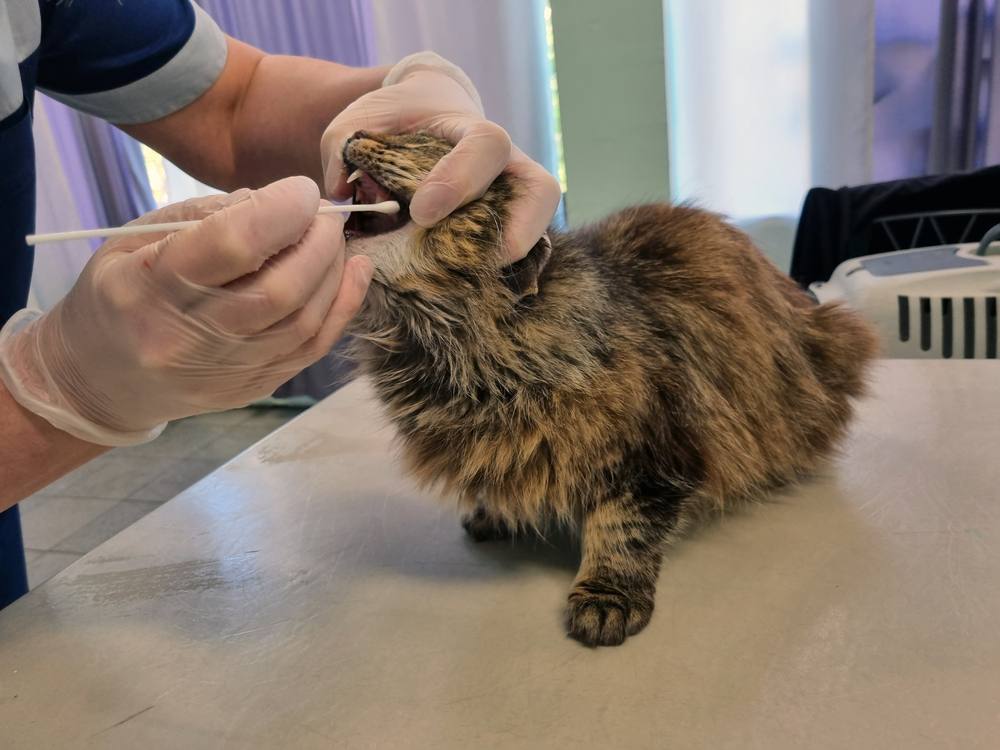
A veterinarian will be able to assess the health of a stray cat, and also check for microchips to locate an owner.
Now you have successfully and humanely captured the stray cat. Ideally, take the cat to the veterinarian for a thorough physical exam and microchip scanning. If you cannot take them to the vet immediately, quarantine them at home in a locked room away from other pets and people in case of any diseases.
Also Read: 10 Most Dangerous Diseases In Cats
How To Find Out If a Stray Cat Has a Home
You can do several things if you’ve been approached by a stray cat or rescued one and suspect they have a home.
1. Establish Whether The Cat Has An Owner
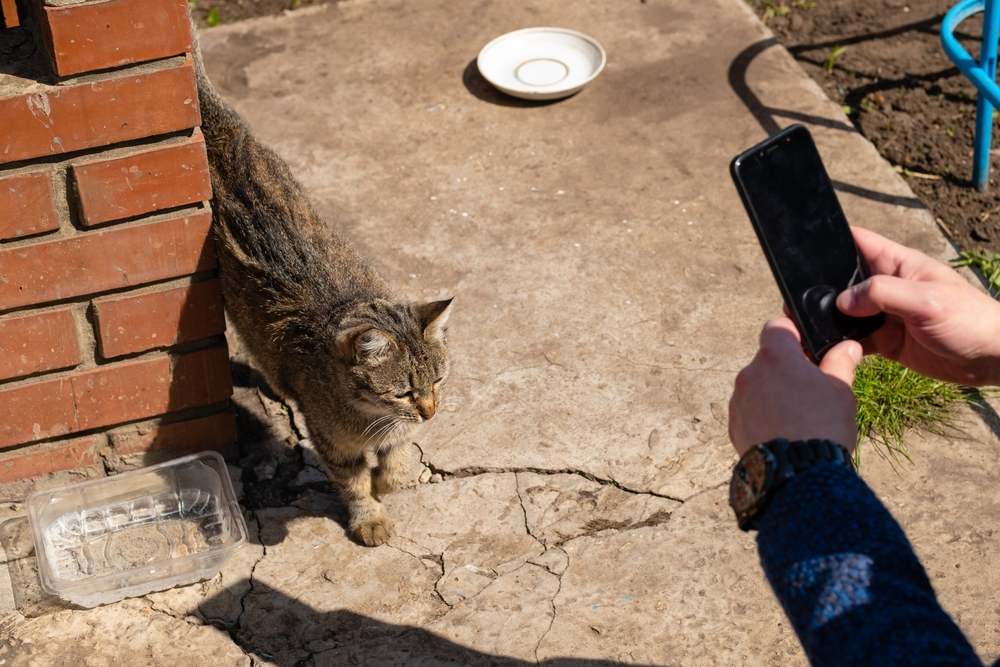
Take a picture of the cat and knock on doors around your neighborhood. Ask neighbors whether anyone lost a cat since we all know how heartbreaking it is when a beloved pet goes missing without a trace.
Check if the stray cat has a collar with a tag that may confirm its owner’s identity. If they don’t, take the cat to the veterinarian or ask a rescue group to check its microchip details.
Suppose the cat isn’t wearing a collar with a tag. Fit the cat with a paper collar with your contact number in the hope that the owner will call you.
Also Read: The 7 Best Cat ID Tags
2. Distribute Flyers And Posters

Flyers in the neighborhood of a found stray cat are often very helpful in locating an owner.
Distribute pamphlets and posters within your neighborhood. Include the reason for the sign, a photo of the cat with unique features, and your contact details. It’s not uncommon for male cats to roam up to half a mile daily.
Also Read: How To Find A Lost Cat
3. Verify Social Media, Including Lost And Found Pet Pages

These days, social media can play a vital role in reuniting lost pets with their owners.
Use social media sites to list the rescued feline. Include the cat’s photo with a detailed location and description to find its guardian. Then submit a found pet report on the Lost and Found Pet Database.
Also Read: Lost and Found Pet Report
4. Check With Vets, Local Shelters, And Pounds
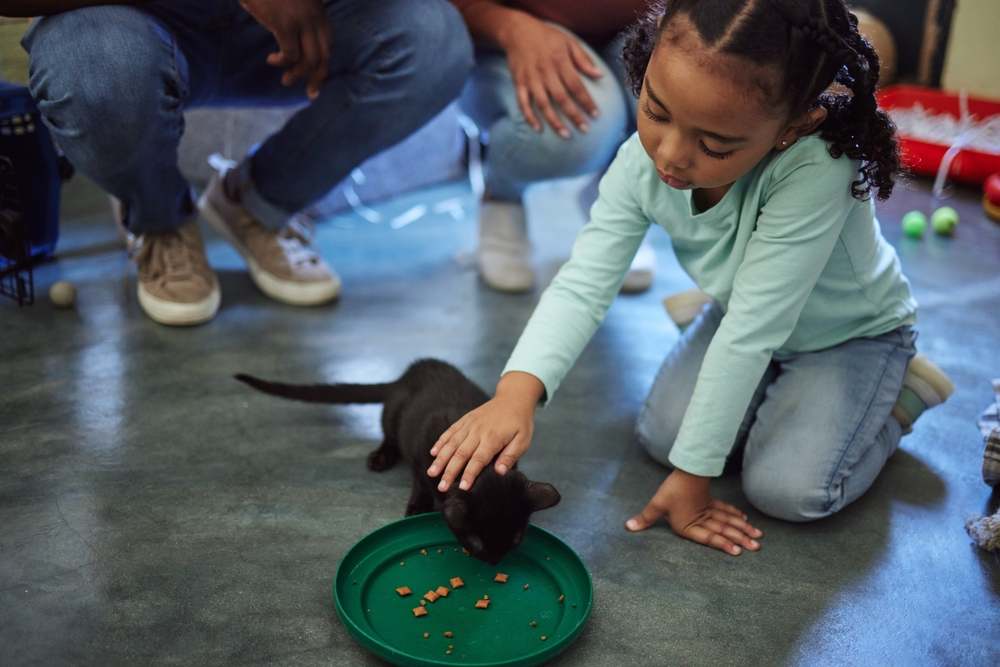
Reuniting a lost cat with its person is very rewarding, and the best thing for the cat.
Check the animal shelter’s website lost and found page or contact shelters, pounds, and vets in your local area in case the owner lost their cat.
Also Read: 10 Key Questions To Ask Before Adopting A New Cat
Final Thoughts
Once you capture a stray cat, you must take it to the vet and look after its well-being. It may take weeks or even months for a stray cat to feel comfortable or settle into a new environment.
If you don’t want to adopt it, consider taking it to an animal shelter rather than leave it to survive in the wild.
Also Read: Can I Change My Adopted Cat’s Name?
-
Allies, A. C. (2022). Feral and Stray CatsAn Important Difference. Retrieved February 10, 2023, from Alley Cat Allies: https://www.alleycat.org/resources/feral-and-stray-cats-an-important-difference/#Difference
-
Halls, V. (2022). Trapping. Retrieved February 09, 2023, from International Cat Care: https://icatcare.org/unowned-cats/feral-street-cats/trapping/
-
Outdoor cats FAQ. (2022). Retrieved February 13, 2023, from The Humane Society of the United States: https://www.humanesociety.org/resources/outdoor-cats-faq







